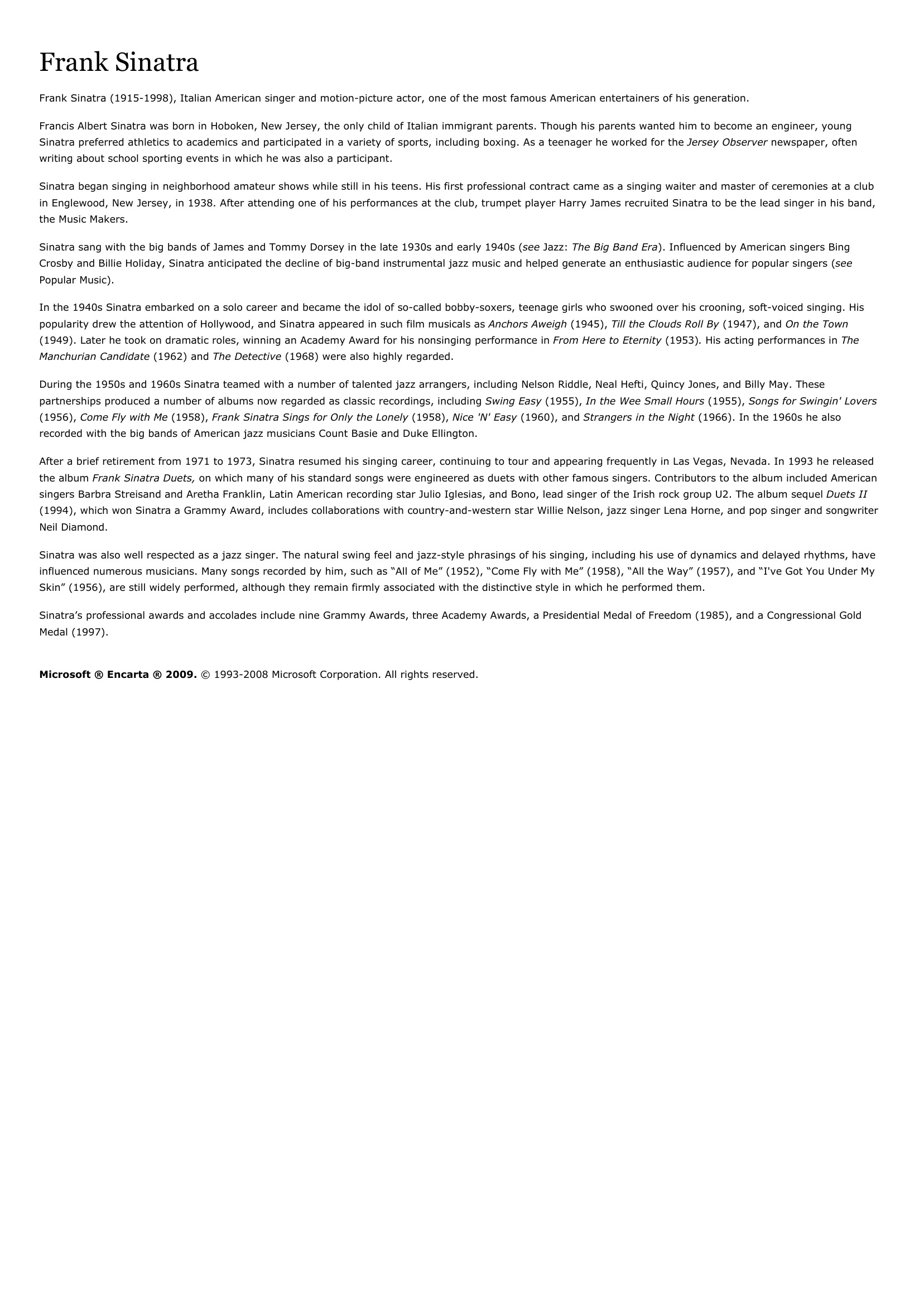Sinatra Frank
Publié le 31/03/2019
Extrait du document
Sinatra Frank
Chanteur et acteur américain
* 12.12.1915, Hoboken, New Jersey
+ 15.05.1998, Los Angeles
C'est avec une voix chaude que ce crooner par excellence, surnommé par ses fans « Ol' blue eyes » et « The Voice », chante deux des chansons les plus connues au monde : \"My way\" et \"Strangers in the night\". Ses autres tubes comptent, entre autres, \"I've got you under my skin\", \"The Lady is a tramp\", \"It was a very good year\", \"New York, New York\" et \"L.A. is my lady\". Après des débuts comme chanteur dans des orchestres de jazz, Sinatra se produit de plus en plus en solo, à partir de 1943. Dans les années 50, il tourne dans des films à succès (\"L'Homme au bras d'or\", 1955). Son rôle dans \"Tant qu'il y aura des hommes\", un film contre la guerre, lui vaut un Oscar en 1953. Pour ses 70 ans, Sinatra, dont la carrière est pourtant jalonnée d'affaires et de rumeurs portant sur ses relations présumées avec la mafia, reçoit la plus haute distinction des Etats-Unis, à savoir la médaille de la liberté. Figure légendaire du show-business, Sinatra donne en 1989 des concerts avec Liza Minelli et Sammy Davis jr., et effectue encore en 1991 une tournée en Europe.
«
Powered by TCPDF (www.tcpdf.org)Frank Sinatra
Frank Sinatra (1915-1998), Italian American singer and motion-picture actor, one of the most famous American entertainers of his generation.
Francis Albert Sinatra was born in Hoboken, New Jersey, the only child of Italian immigrant parents.
Though his parents wanted him to become an engineer, youngSinatra preferred athletics to academics and participated in a variety of sports, including boxing.
As a teenager he worked for the Jersey Observer newspaper, often writing about school sporting events in which he was also a participant.
Sinatra began singing in neighborhood amateur shows while still in his teens.
His first professional contract came as a singing waiter and master of ceremonies at a clubin Englewood, New Jersey, in 1938.
After attending one of his performances at the club, trumpet player Harry James recruited Sinatra to be the lead singer in his band,the Music Makers.
Sinatra sang with the big bands of James and Tommy Dorsey in the late 1930s and early 1940s ( see Jazz: The Big Band Era ).
Influenced by American singers Bing Crosby and Billie Holiday, Sinatra anticipated the decline of big-band instrumental jazz music and helped generate an enthusiastic audience for popular singers ( see Popular Music).
In the 1940s Sinatra embarked on a solo career and became the idol of so-called bobby-soxers, teenage girls who swooned over his crooning, soft-voiced singing.
Hispopularity drew the attention of Hollywood, and Sinatra appeared in such film musicals as Anchors Aweigh (1945), Till the Clouds Roll By (1947), and On the Town (1949).
Later he took on dramatic roles, winning an Academy Award for his nonsinging performance in From Here to Eternity (1953) .
His acting performances in The Manchurian Candidate (1962) and The Detective (1968) were also highly regarded.
During the 1950s and 1960s Sinatra teamed with a number of talented jazz arrangers, including Nelson Riddle, Neal Hefti, Quincy Jones, and Billy May.
Thesepartnerships produced a number of albums now regarded as classic recordings, including Swing Easy (1955), In the Wee Small Hours (1955), Songs for Swingin' Lovers (1956), Come Fly with Me (1958), Frank Sinatra Sings for Only the Lonely (1958), Nice 'N' Easy (1960), and Strangers in the Night (1966).
In the 1960s he also recorded with the big bands of American jazz musicians Count Basie and Duke Ellington.
After a brief retirement from 1971 to 1973, Sinatra resumed his singing career, continuing to tour and appearing frequently in Las Vegas, Nevada.
In 1993 he releasedthe album Frank Sinatra Duets, on which many of his standard songs were engineered as duets with other famous singers.
Contributors to the album included American singers Barbra Streisand and Aretha Franklin, Latin American recording star Julio Iglesias, and Bono, lead singer of the Irish rock group U2.
The album sequel Duets II (1994), which won Sinatra a Grammy Award, includes collaborations with country-and-western star Willie Nelson, jazz singer Lena Horne, and pop singer and songwriterNeil Diamond.
Sinatra was also well respected as a jazz singer.
The natural swing feel and jazz-style phrasings of his singing, including his use of dynamics and delayed rhythms, haveinfluenced numerous musicians.
Many songs recorded by him, such as “All of Me” (1952), “Come Fly with Me” (1958), “All the Way” (1957), and “I've Got You Under MySkin” (1956), are still widely performed, although they remain firmly associated with the distinctive style in which he performed them.
Sinatra’s professional awards and accolades include nine Grammy Awards, three Academy Awards, a Presidential Medal of Freedom (1985), and a Congressional GoldMedal (1997).
Microsoft ® Encarta ® 2009. © 1993-2008 Microsoft Corporation.
All rights reserved..
»
↓↓↓ APERÇU DU DOCUMENT ↓↓↓
Liens utiles
- Sinatra Frank Chanteur et acteur américain
- Sinatra Frank
- Sinatra, Frank - jazz.
- Sinatra, Frank - acteur / actrice.
- Frank Sinatra Frank Sinatra (1915-1998), Italian American singer and motion-picture actor, one of the most famous American entertainers of his generation.

































